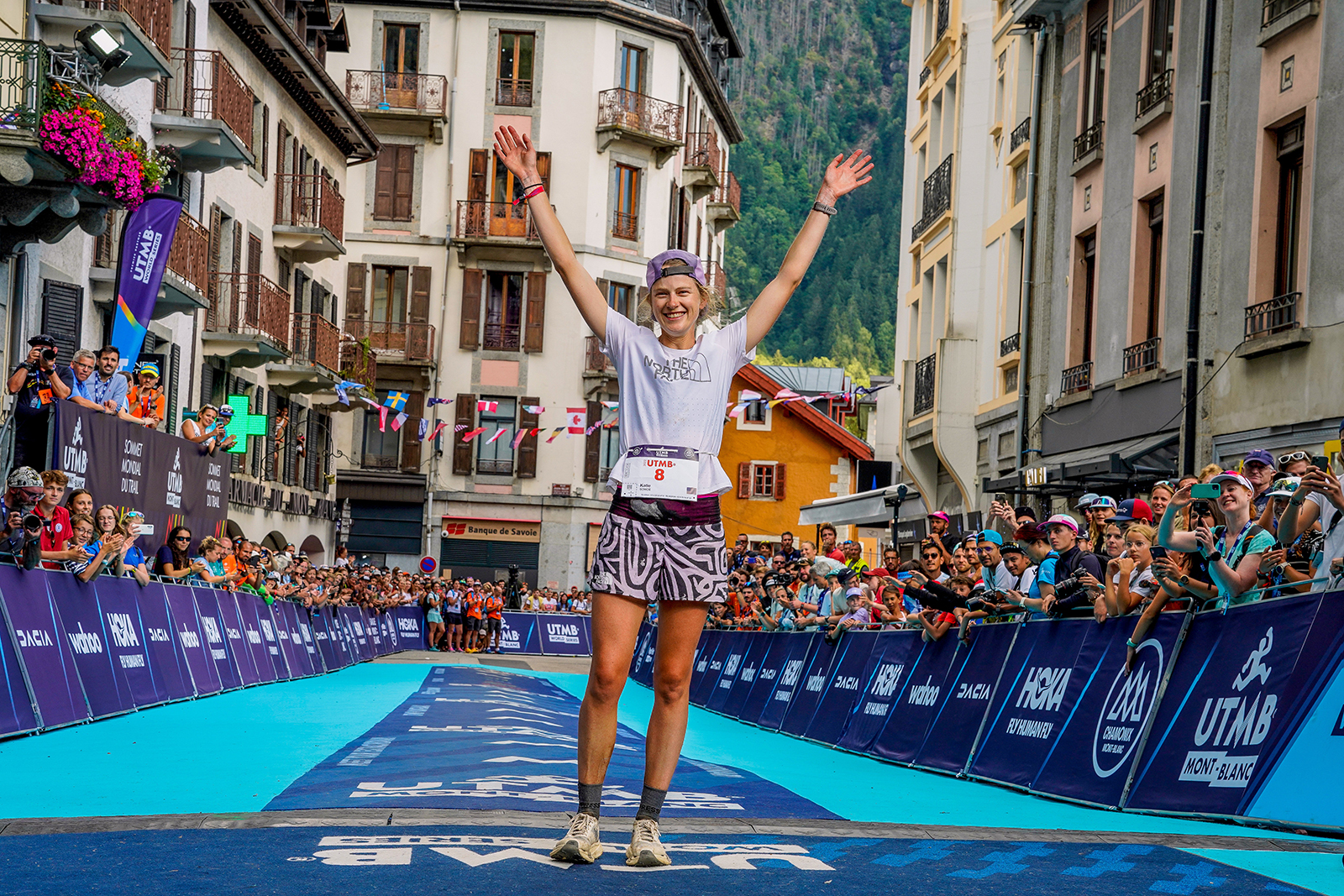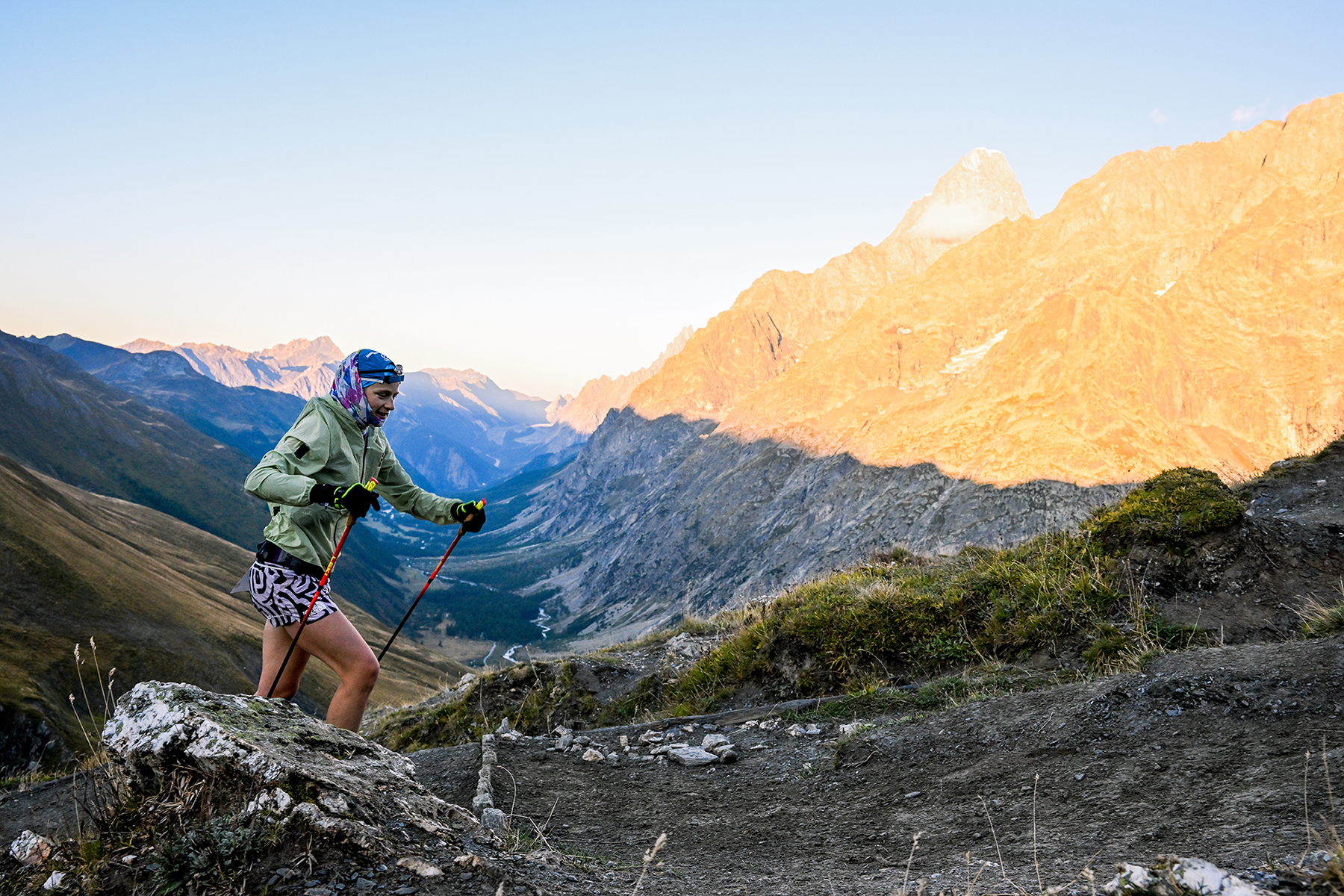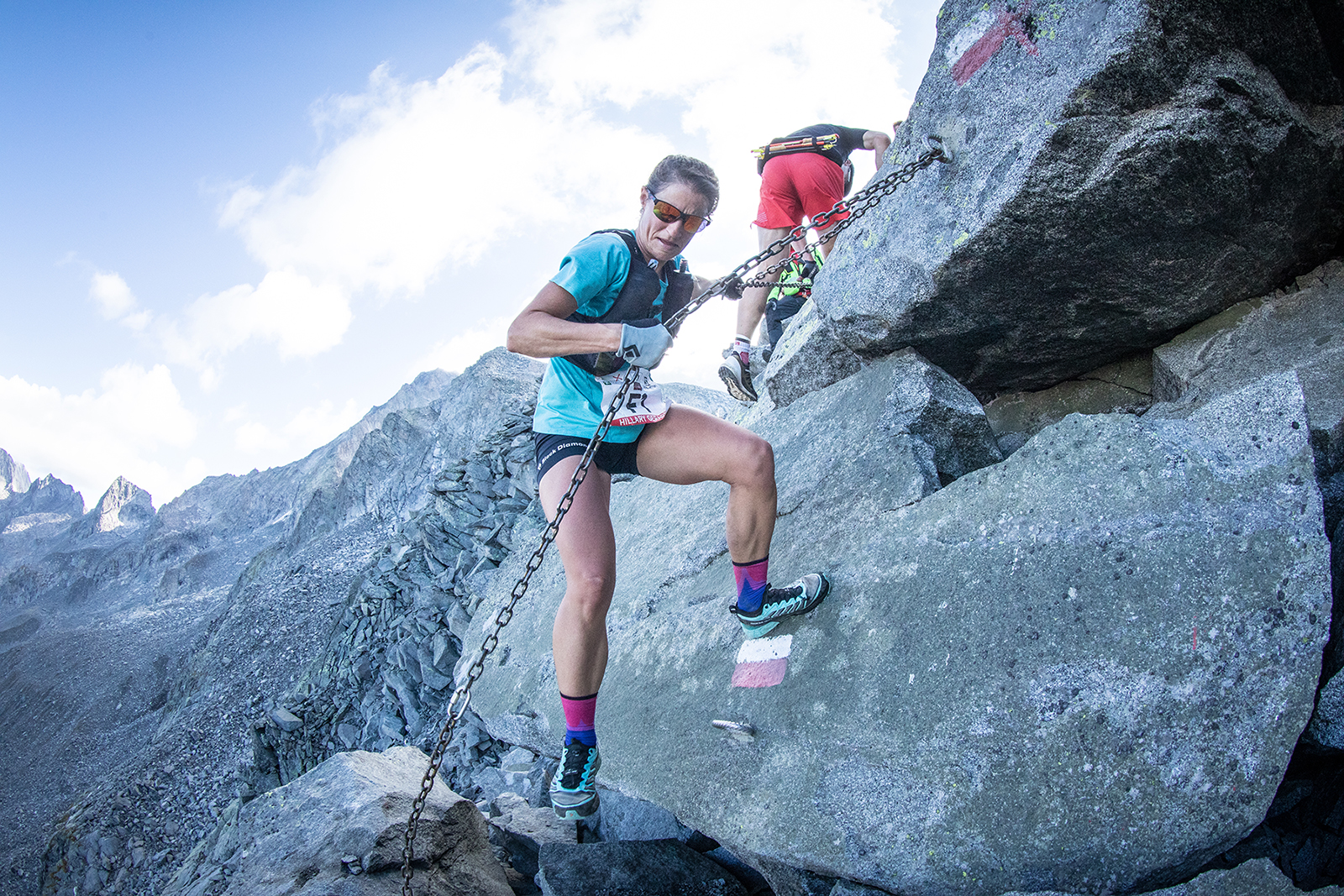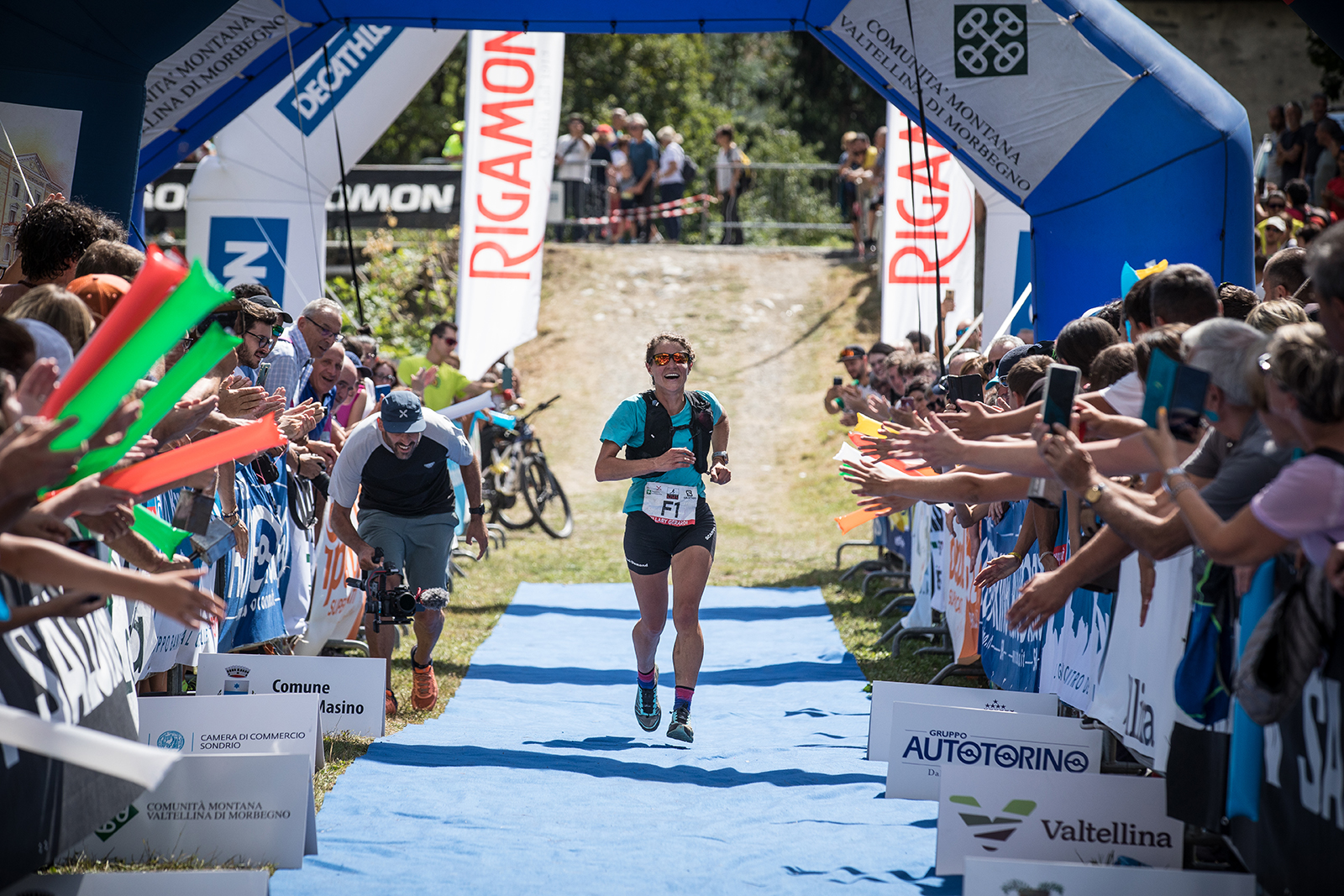This story is a preview of the upcoming issue of Appalachia Journal.

Former Appalachian Mountain Club hutmaster Katie Schide overcame fatigue and a queasy stomach to win the world’s most prestigious trail race, the Ultra Trail du Mont-Blanc, on August 27, 2022.
Courtesy of UTMB
Katie Schide ran down the woodsy mountain trail from the Flégère tram station 800 meters above Chamonix, France, this past August 27, much like it was the Valley Way between the Appalachian Mountain Club’s Madison Spring Hut and Route 2 in Randolph, New Hampshire. In many ways, the trails are similar. Under canopies of trees, the terrain in both places veers toward rocky and rooty. “Technical,” a trail runner would call it. Despite passing such distinctly French landmarks as Chalet Floria, a cozy chalet where hikers look for wild berry tart or café au lait, one could almost imagine her mind wandering, thinking she was back working for the AMC hut system, almost down to the AMC pack house with her load.
Not this time, though. Not by a long shot. This time, she was not working as the Madison hutmaster as she was in 2013. She was headed down into a narrow corridor of thousands of people from around the world, all awaiting her arrival as the first woman to finish the 2022 Ultra Trail du Mont-Blanc, or UTMB, the world’s most prestigious trail race. And instead of sporting a Mount Madison Volunteer Ski Patrol T-shirt, she wore the latest shoes, clothing, and trail-running vest from The North Face, her sponsor.
As she hit pavement on the outskirts of town, having run nearly 170 kilometers in the past 23 hours, Schide had one lingering thought: “Just don’t do anything stupid.” Fatigued and sleep-deprived, it would be easy to make a simple mistake.
The consequences would be high. UTMB is far and away the world’s most important trail race. Looping around Mont Blanc on the iconic Tour du Mont Blanc hiking path, the race passes from France into Italy, Switzerland, then back into France, finishing where it started, at Place du Triangle de l’Amitié, directly in front of the mayor’s office, a few feet from the steps of the old Saint Michel church. It’s a route that takes strong hikers eight days to complete. Since its daring inception two decades ago, UTMB has grown to become the Super Bowl of trail running. Runners work for a year or more to qualify, then must enter a lottery to secure one of the coveted 2,500 starting places.
UTMB is considered the most competitive ultramarathon race anywhere. Schide faced stiff competition, notably from Canadian runner Marianne Hogan, who led for a key section of the race about 100 kilometers in as runners climbed the 8,323-foot-high Grand Col Ferret and crossed the Italian border into Switzerland. Feeling good at the start of the race, Schide had gone out fast, knowing it was possible that the speed up front would cost her later. The crash came, and hard, 12 hours 23 minutes later, 98 kilometers into the race, at Arnouvaz, a small outpost in Italy’s Val Ferret. At an aid station there, Schide downed a Coke, hoping for quick calories. Almost immediately, she threw up. Not long after, Hogan blew by. “She passed me like I was standing still,” Schide remembered. “I thought, ‘Well, that’s it. I’ll just let her go. I’m still near the front of the race.’”
As it turned out, the two were on a record-setting pace that neither could sustain. At the next aid station, in La Fouly, Switzerland, with 59 kilometers left to go, Schide quickly inhaled a cheese sandwich. It was, in a sense, based on experience. Her ultrarunning friend, Camille Bruyas, had done the same thing the year prior, going on to finish second in UTMB. The sandwich stayed down, and the fuel did the trick. Schide steadily closed a twenty-minute gap, then passed Hogan. “OK . . . I passed the girl who was first,” she thought to herself. “That must mean . . . I’m in first.” It was the kind of simple, declarative thinking to which all runners are reduced after a dozen or more hours on the trail which, in the case of UTMB, also meant passing through at least one full night. “I was kind of blacked out,” she said. She does remember her coach, Jason Koop, telling her at the Trient, Switzerland, aid station, “All you need to do is take care of yourself.”
If there was a certain amount of luck involved to be passing Hogan, a lot more of the reason came down to hard work and experience. For Schide, it all started in the White Mountains. Growing up in Gardiner, Maine, Schide’s summer vacations were spent backpacking Vermont’s 272-mile-long Long Trail. There were trips to the White Mountains, and on an overnight trip to an AMC hut, Schide found herself drawn to the work of the college-age crew—called the croo. “They were having so much fun working together,” she says. She applied and was hired. Schide went to Middlebury College in Vermont, with summers spent in the hut system. She worked at Greenleaf Hut in 2011, then worked the following two summers at Madison Spring Hut as assistant hutmaster and then hutmaster, and finished off her huts seasons at Lakes of the Clouds Hut in 2014, as hutmaster.
During that time, Schide developed a mountain toughness and speed over rugged terrain that served her well at UTMB and countless other Alps trail races. On days off, she sped over the rocky alpine terrain of the Whites, visiting friends who worked at distant huts. When packing supplies up from the valley, she often found herself pushing hard uphill, a heavy load of fresh vegetables tied to the wooden pack frames used by hut crews. The goal was simple: get to the hut by 5 p.m., the time that crews gathered to prepare meals for as many as 100 guests. “We’d have an eye on our watches, pushing hard, wondering, ‘Am I going to make it?’” she said. “Everyone needed to be in the kitchen with their apron on for ‘Go Time.’ You didn’t want to let the team down,” said Schide.
Her fitness grew during her four seasons in the huts. “We didn’t think of it as running, even though we were wearing trail-running shoes,” Schide explains. “Running was training for field hockey, nothing more. I once ran a half-marathon. I wasn’t the least bit competitive. But when I look back, we were trail running. We used exactly the sort of pace as a lot of the longer races that I’m doing now.”

Schide at high elevation on the UTMB route. Racing over this terrain felt like rushing back to one of the AMC huts to serve the guests dinner.
Courtesy of UTMB
In 2014, Schide finished her last season in the huts and headed west to pursue a master in geology degree at the University of Utah in Salt Lake City. She ran a few trail races and had strong results on the speedier, less technical western terrain, coming in first or second in races in Logan, Antelope Island, and Moab, Utah.
Across the Atlantic
The advanced degree work continued, and in 2015 she moved to Switzerland, where she had been accepted at ETH Zurich, the prestigious technical university. It was a unique opportunity to work toward her PhD in geology. Schide kept running. Her roommate suggested nearby Uetliberg, a small, 1,500-foot-high peak in Zurich’s forest on the border of the city. Schide had already done it—sometimes six times in a day.
In Grenoble, France, everything started to change. There, she connected with an older former AMC croo member, Hillary Gerardi. Both had grown up in New England and gone to Middlebury College. Gerardi, five years older than Schide, arrived in France in 2010 to teach English at the American School in Grenoble with her husband, Brad Carlson. In 2017, they moved to Chamonix. Carlson went on to become the first American to become a member of Chamonix’s prestigious Compagnie des Guides.
“By that point in my time in Zurich,” Schide says, “I had met everyone in my office who said they liked to go hiking. I like to go hiking too,” she laughs, “Just faster.”
Schide and Gerardi ran one of the classic European races, Grenoble’s Verticale du Grand-Serre. Just 1.8 kilometers, it was the shortest race either had ever done. The hitch? The course climbs 1,000 meters. Imagine, for example, climbing over 3,000 feet up one Tuckerman Ravine headwall after another. That is Grand-Serre. It was, said Schide, “A late-for-go-time hike.”
Two weeks later, the two former hut croo members headed to Limone, Italy, to run what is known as an extreme skyrace—a mountain run that is steep and technical, demanding a head for heights and finely tuned fitness. They didn’t go for the competition, however. “Hillary told me the race was known for having a really fun dance party,” says Schide, “And it was her 30th birthday.”
Going to Limone proved to be a fortuitous choice for Schide. There she met Germain Grangier, an endearing French trail runner with a wicked sense of humor. Grangier, humble and laugh-out-loud funny, is one of Europe’s most admired trail runners. Like Schide, he has some impressive results: two top-ten finishes at UTMB, fifth at the UTMB 100 km-long CCC (which stands for Courmayeur–Champex–Chamonix), and a third-place finish in Chamonix’s 90-kilometer race. Today Schide and Grangier are partners; they live in Isola in France’s Maritime Alps. Though in the mountains, it is just 45 miles from Nice, on France’s southern coast.
Limone launched Schide’s European running career. In the years since, she has stood on the podium at some of Europe’s most prestigious mountain races: She has won Chamonix, France’s rugged 90-kilometer trail race, finished second place in the 115-kilometer race on Portugal’s Madeira Island and in Italy’s Lavaredo race, and more. The Swiss trail-running brand, On, signed Schide as one of their marquee mountain athletes. This past year, she moved to The North Face.
In 2018, Schide ran the CCC trail race, part of the UTMB series of races. An extraordinarily competitive race, she came in second. During the run, she found herself returning in her mind to the White Mountains. “There was a moment when I had a distinctive flashback to hiking across the ridge from Madison Spring Hut to Lakes of the Clouds Hut, early in the morning, passing hikers in full Gore-Tex, while I was in a T-shirt and gloves.” Thousands of miles away from the White Mountains, in a sense, she knew not just the terrain, but also the mountain weather. “When you spend four summers running around in cold fog,” Schide told me, “it doesn’t really faze you anymore.”
With Grangier, Schide returned to the White Mountains in July 2019, setting a new record on the 49-mile-long Hut Traverse, which connects all eight of AMC’s high huts. She finished in 12:23:06, knocking more than two hours off the prior fastest time. Schide enjoyed sharing familiar trails with Grangier, who was astounded by the terrain. “You’re not on a technical ridgeline in the Alps,” said Schide, but it’s still hard. Germain was telling me, ‘We’re scrambling . . . and we’re below treeline!’”
Comparing the two ranges, Schide has come to realize that the White Mountains were an ideal training ground for the Alps. “The White Mountains got me comfortable with technical terrain,” she said. “And fast hiking for hours.” These are two of the top skills needed to move up in the pack during a trail race in the Alps. “What I sense from American trail runners is that they don’t think of hiking as racing,” said Schide. “But here, when go out for a fast hike, I say, ‘I went trail running.’”
Intertwined Rises in Mountain Running
If Gerardi and Schide’s lives were intertwined to this point, they became much more so on the last weekend of August 2022. Remarkably, just a few hours after Katie Schide won UTMB, Gerardi was accomplishing something just as challenging—if less famous—and reaching one of the pinnacles of her own trail-running career.

Hillary Gerardi lowers herself down a boulder during the brutal 52-kilometer Trofeo Kima race in Italy. She won.
Copyright: Foto Maurizio Torri
In the years since she and Schide connected in Grenoble, Gerardi’s mountain running evolution had taken an equally impressive if slightly different direction. She excelled at steep, airy, and highly technical races. She was among the top three at a long list of tough European competitions, including winning or being on the podium at Chamonix’s “Vertical Kilometer,” Scotland’s Glen Coe Skyline, and Madeira Island’s Ultra SkyMarathon. Sponsorships soon followed, and today Gerardi is with the international mountain equipment brand Black Diamond. With a friend who is one of France’s top ski mountaineering racers, she established a women’s speed record on the famous Haute Route Ski Tour from Chamonix to Zermatt, Switzerland, in 26 hours and 21 minutes.
There was some overlap between Gerardi and Schide, too. In 2021, two years after Schide won Chamonix’s tough 90-kilometer trail race, it was Gerardi’s turn. What Hillary Gerardi did that Sunday was set a course record on what is widely considered one of the most fearsomely technical trail races in the world in the tiny town of Val Masino, Italy. Located about 135 miles (217 kilometers) from Chamonix as the crow flies, this race is on a par with UTMB, although very different from it, especially in its lack of hype. Gerardi’s personal goal that day was simple, if exceedingly challenging: set a new women’s course record in the race currently known as Trofeo-Kima. Most people have never heard of this race, but to the trail-running cognoscenti, Kima is on a par with UTMB.
In Gerardi’s airy world, Kima is the stuff of legend. By the stats, it sounds almost average for a big Alps trail race: 52 kilometers long, with 4,800 meters of climbing. Reaching a height of 2,570 meters above sea level (8,432 feet), the route traverses seven high mountain passes. Yet it is not the climbing or the distance that distinguishes Kima. It is perhaps the most technically demanding mountain race in the world: part technical climbing, part trail running. The route is highly exposed in places. Chains bolted to the sides of cliffs provide security against falls that could easily be deadly. For much of the route, the route just follows blazes on rocks above treeline.
Gerardi thrives at races like Kima. She won the race in 2018, narrowly missing the women’s course record by less than 90 seconds, although she didn’t know it at the time. After that race, she felt fully spent, unsure if she could have broken the record even if she had known about it.
Four years later, in 2022, on the same weekend Schide won UTMB, Gerardi ran Kima, completing one of the greatest races of her life and ticking off her big goal of the year. She moved quickly through vertiginous, rocky terrain that would terrify most trail runners, besting the prior women’s record by more than five minutes. What she accomplished was flat-out astounding. Yet beyond the confines of the arcane world of skyrunning, barely a soul noticed.

Hillary Gerardi crosses the finish line of the grueling Trofeo-Kima race, which covers 52 kilometers over seven mountain passes.
Copyright: Foto Maurizio Torri
A Return to the Whites—and Another Record
Kima done, Gerardi had something else on her list, too, and in September she returned to the White Mountains to quietly set a new women’s record on the iconic route known as the Mahoosuc Traverse, from Grafton, Maine, to Gorham, New Hampshire. The 28 miles with nearly 11,000 feet of climbing is technical and rugged and includes the rock jumble that is Mahoosuc Notch, widely considered the hardest mile of the Appalachian Trail.
In many ways, the challenge jibed nicely with the training she had done for Kima. Still, Gerardi was apprehensive. “I spent all my time running in the Alps, I was worried I had forgotten how the Whites compared.” She scouted the route, running the first half with an old hut croo friend and trail runner, Jess Marion, and Jess’s husband, Lincoln Benedict.
This past October 2, Gerardi’s father dropped her off at Grafton Notch, saying, simply “Bye! Have a good day, Honey!” Tempering her pace out of uncertainty, Gerardi never pushed into her red zone—that perilous place where one is pushing so hard that they cannot maintain that pace for long, and a crash will ensue sooner or later. The terrain demanded a high level of concentration. “It was a really long mindfulness exercise,” she said. It went well—so well, in fact, that Gerardi finished faster than not just the women’s record but also the overall record: 7 hours 16 minutes.
Historic Double Win
In the Alps, the weekend of August 27–28, 2022, resonated far beyond, back to another time and place, more than a decade earlier and thousands of miles away. Two former AMC hut croo members ran two big races—Schide the UTMB and Gerardi the Trofeo Kima—each race filled with passion, but so very different. Gerardi and Schide next turned their attention to training for the summer of 2023. Gerardi was planning a mix of technical sky races and personal projects. Schide was turning her attention to something different: a go at the 100-mile-long Western States Endurance Run, June 24.
For both Schide and Gerardi, the memories will linger for the rest of their lives. Gerardi landed a coveted course record she had eyed for years, on one of mountain running’s most demanding routes. And Schide got to run her final kilometers flawlessly, crossing trail running’s most famous finish line in 23:15:12, and getting what she wanted most in that moment: to be done.
If you enjoyed this story, you might consider subscribing to our Appalachia Journal.